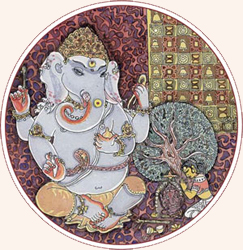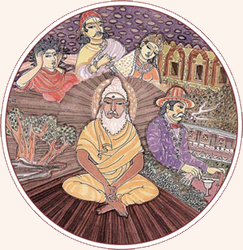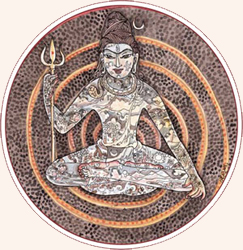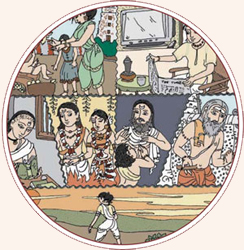Four Facts of Hinduism: Karma, Reincarnation, All-Pervasive Divinity, and Dharma
1. Karma

A devotee prays to a small image of Ganesha, who hovers nearby in His subtle body, blessing her life and guiding her karmas.§
Karma literally means “deed” or “act” and more broadly names the universal principle of cause and effect, action and reaction which governs all life. ¶Karma is a natural law of the mind, just as gravity is a law of matter. Karma is not fate, for man acts with free will, creating his own destiny. The Vedas tell us, if we sow goodness, we will reap goodness; if we sow evil, we will reap evil. Karma refers to the totality of our actions and their concomitant reactions in this and previous lives, all of which determines our future. ¶It is the interplay between our experience and how we respond to it that makes karma devastating or helpfully invigorating. The conquest of karma lies in intelligent action and dispassionate reaction. Not all karmas rebound immediately. Some accumulate and return unexpectedly in this or other births.§
According as one acts, so does he become. One becomes virtuous by virtuous action, bad by bad action. §
YAJUR VEDA, BRIHADARANYAKA UPANISHAD 4.4.5
2. Reincarnation

In the center, we see a yogi. Behind him are depictions of how he looked and dressed in four earlier incarnations. §
Reincarnation, punarjanma, is the natural process of birth, death and rebirth. At death we drop off the physical body and continue evolving in the inner worlds in our subtle bodies, until we again enter into birth. ¶Through the ages, reincarnation has been the great consoling element within Hinduism, eliminating the fear of death. We are not the body in which we live but the immortal soul which inhabits many bodies in its evolutionary journey through samsara. After death, we continue to exist in unseen worlds, enjoying or suffering the harvest of earthly deeds until it comes time for yet another physical birth. The actions set in motion in previous lives form the tendencies and conditions of the next. Reincarnation ceases when karma is resolved, God is realized and moksha, liberation, is attained.§
After death, the soul goes to the next world, bearing in mind the subtle impressions of its deeds, and after reaping their harvest returns again to this world of action. Thus, he who has desires continues subject to rebirth.§
YAJUR VEDA, BRIHADARANYAKA UPANISHAD 4.4.6
3. All-pervasive Divinity

God’s all-pervasive, immanent nature is portayed here. Siva is seated against a backdrop of swirling shakti. His body is made up of the elements, galaxies, mountains, rivers, animals and manifestations of all kinds, thus depicting Him as inherent in His creation. §
As a family of faiths, Hinduism upholds a wide array of perspectives on the Divine, yet all worship the one, all-pervasive Supreme Being hailed in the Upanishads. As Absolute Reality, God is unmanifest, unchanging and transcendent, the Self God, timeless, formless and spaceless. As Pure Consciousness, God is the manifest primal substance, pure love and light flowing through all form, existing everywhere in time and space as infinite intelligence and power. As Primal Soul, God is our personal Lord, source of all three worlds, our Father-Mother God who protects, nurtures and guides us. We beseech God’s grace in our lives while also knowing that He/She is the essence of our soul, the life of our life. Each denomination also venerates its own pantheon of Divinities, Mahadevas, or “great angels,” who were created by the Supreme Lord and who serve and adore Him.§
He is the God of forms infinite in whose glory all things are—smaller than the smallest atom, and yet the Creator of all, ever living in the mystery of His creation. In the vision of this God of love there is everlasting peace. He is the Lord of all who, hidden in the heart of things, watches over the world of time. §
KRISHNA YAJUR VEDA, SHVETASHVATARA UPANISHAD 4.14-15.
4. Dharma

Dharma embraces one’s duties and obligations, and changes according to life’s four natural stages of life: student, householder, elder advisor and religious solitaire, as show in this illustration. §
When God created the universe, He endowed it with order, with the laws to govern creation. Dharma is God’s divine law prevailing on every level of existence, from the sustaining cosmic order to religious and moral laws which bind us in harmony with that order. Related to the soul, dharma is the mode of conduct most conducive to spiritual advancement, the right and righteous path. It is piety and ethical practice, duty and obligation. When we follow dharma, we are in conformity with the Truth that inheres and instructs the universe, and we naturally abide in closeness to God. Adharma is opposition to divine law. Dharma is to the individual what its normal development is to a seed—the orderly fulfillment of an inherent nature and destiny. §
Dharma yields Heaven’s honor and Earth’s wealth. What is there then that is more fruitful for a man? There is nothing more rewarding than dharma, nor anything more ruinous than its neglect.§